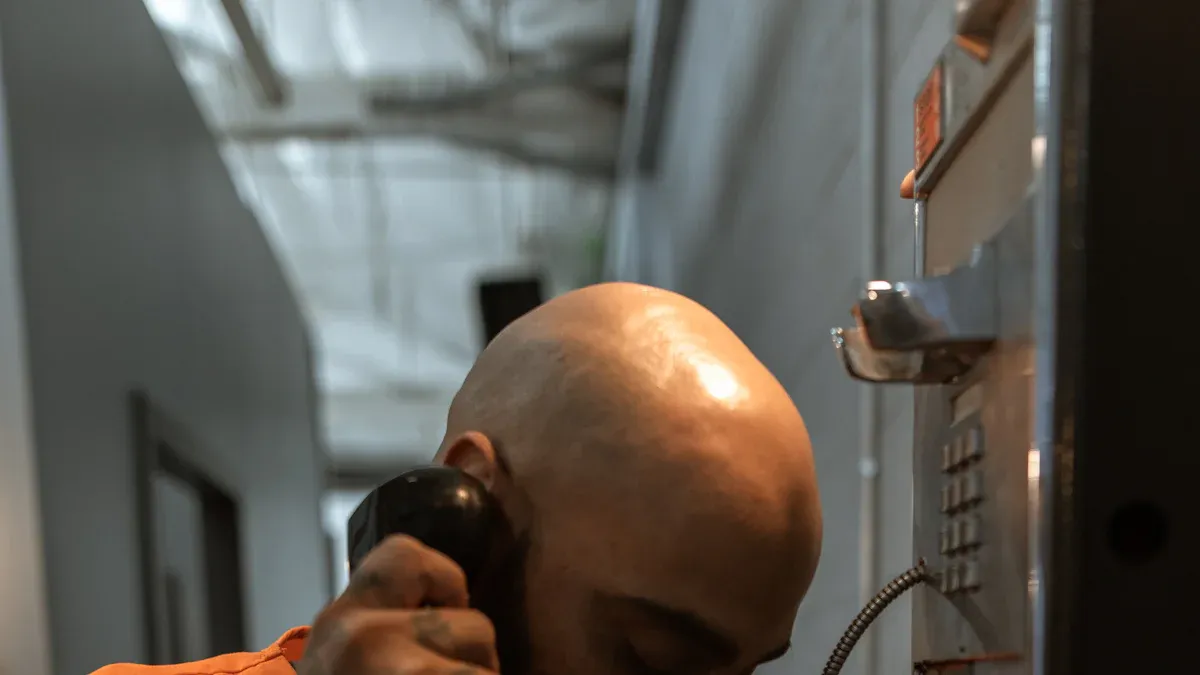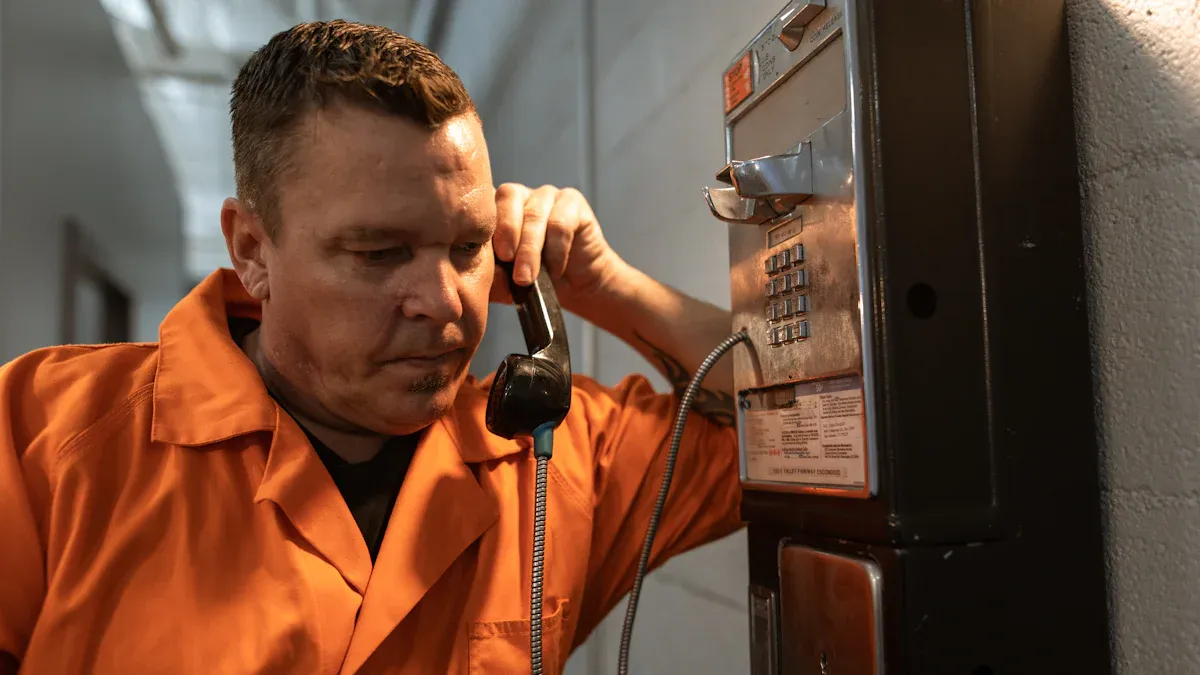
Prison communication systems often fail to meet the needs of inmates and their families. Surveys reveal that over 50% of ex-offenders struggle to rebuild family ties after release, despite initial optimism. The MQPL Surveys and other recent studies highlight widespread issues in correctional communication, emphasizing the need for secure and reliable tools. The Rugged Wall Mounted Inmate Telephone With Volume Control Button JWAT137 directly tackles these challenges. Its tamper-resistant design, stainless steel construction, and user-friendly features ensure durability, security, and ease of use in demanding environments. Additionally, this innovative device is comparable to a mining Industrial Telephone, providing robust communication solutions in harsh conditions. For facilities requiring specialized equipment, the ATEX Explosion Proof Telephone offers safety in explosive environments, while the auto dial emergency telephone ensures immediate access to help when needed.
Common Challenges in Prison Communication

Limited Access to Reliable Communication Tools
Correctional facilities often struggle to provide inmates with dependable communication systems. Many prisons rely on outdated technology that fails to meet modern standards. Gang influence exacerbates this issue, as incarcerated individuals frequently manipulate communication tools to coordinate illicit activities. Cybersecurity vulnerabilities further complicate the situation, leaving systems exposed to breaches that compromise sensitive information. Additionally, mail scanning policies, intended to prevent contraband, undermine the privacy and emotional value of correspondence. Critics argue that these measures lack solid evidence of effectiveness and may inadvertently increase the flow of prohibited items.
| Challenge Type | Description |
|---|---|
| Gang Influence | A significant portion of the incarcerated population is involved with gangs, leading to increased violence and manipulation of communication. |
| Cybersecurity Vulnerabilities | Correctional facilities face growing cybersecurity risks, with many systems inadequately protected against breaches. |
| Mail Scanning Policies | The practice of scanning mail undermines privacy and may not effectively prevent contraband, impacting communication. |
High Costs for Inmates and Their Families
The financial burden of prison communication systems weighs heavily on inmates and their families. Families spend approximately $2.9 billion annually on commissary accounts and phone calls. The average family incurs about $13,000 in fines and fees during a loved one’s incarceration. Individuals like Kae Boone, who spends $100 monthly on toiletries and food for her incarcerated boyfriend, highlight the strain these costs impose. Over two years, Boone estimates her expenses have exceeded $10,000, illustrating the long-term financial impact of supporting an inmate.
Security and Privacy Concerns in Existing Systems
Existing prison communication systems often fail to protect the privacy of inmates and their contacts. Mail digitization systems retain personal information, while original letters are withheld. The Smart Communications system deters individuals from sending personal images due to fears of data storage. Breaches further erode trust; for example, a 2015 incident involving Securus exposed 70 million phone calls, including 14,000 attorney-client conversations. Such lapses highlight the urgent need for secure and reliable communication solutions like the Rugged Wall Mounted Inmate Telephone With Volume Control Button JWAT137.
Introducing the JWAT137 Rugged Wall Mounted Inmate Telephone With Volume Control Button

Overview of the JWAT137 and Its Purpose
The JWAT137 Rugged Wall Mounted Inmate Telephone With Volume Control Button is a cutting-edge communication device tailored for correctional facilities. Its primary purpose is to provide inmates with a secure and reliable means of communication while addressing the unique challenges of prison environments. This telephone is constructed from vandal-resistant materials, ensuring durability and long-term functionality. It incorporates advanced security features, such as tamper-resistant screws, to prevent misuse or damage. The device also offers high corrosion resistance and mechanical strength, making it suitable for harsh conditions.
One of its standout features is the volume control button, which enhances user convenience by allowing inmates to adjust call volume according to their needs. This thoughtful design prioritizes accessibility and usability, ensuring that communication remains clear and effective. By combining robust construction with user-friendly features, the JWAT137 serves as a dependable solution for improving inmate communication systems.
Key Design Features for Correctional Facilities
The JWAT137 boasts several design elements that make it ideal for correctional facilities. Its body is crafted from SUS304 stainless steel, a material known for its exceptional strength and resistance to impact. This ensures the telephone can withstand significant force, reducing the likelihood of damage in high-risk environments. The handset is designed to endure up to 100kg of force, further enhancing its durability.
The device’s tamper-resistant design includes a strategically placed cable entrance at the back, minimizing the risk of unauthorized access. Its full zinc alloy keypad is weather-sealed, ensuring reliable performance in various environmental conditions. Additionally, the magnetic hook switch and optional noise-canceling microphone improve call clarity, even in noisy surroundings. These features collectively make the JWAT137 a robust and secure communication tool for correctional facilities.
How the JWAT137 Solves Communication Challenges

Secure and Tamper-Resistant Design
The JWAT137 Rugged Wall Mounted Inmate Telephone With Volume Control Button prioritizes security through its tamper-resistant construction. Its SUS304 stainless steel body offers exceptional mechanical strength, ensuring the device remains operational even under extreme conditions. The handset, capable of withstanding up to 100kg of force, further enhances its durability. The strategically placed cable entrance at the back minimizes the risk of unauthorized access, making it ideal for correctional facilities.
Several certifications validate the secure design of the JWAT137. Compliance with FCC, CE, RoHS, and ISO9001 standards demonstrates adherence to international safety and quality requirements. These certifications reflect the device’s ability to meet rigorous security demands, ensuring reliable performance in high-risk environments. Correctional facilities benefit from these features by reducing the likelihood of tampering and misuse, fostering a safer communication system for inmates and staff alike.
Cost-Effective and Accessible Communication
The JWAT137 addresses the financial strain associated with prison communication systems. Its design integrates seamlessly with standard telephone line power supplies, eliminating the need for costly infrastructure upgrades. Facilities can install the device using just four screws, reducing installation expenses and downtime. This simplicity ensures that correctional institutions can implement the system without incurring excessive costs.
For inmates and their families, the JWAT137 provides a more affordable communication option. By offering reliable functionality without hidden fees or complex billing systems, the device alleviates the financial burden of staying connected. Families, who often face significant expenses during a loved one’s incarceration, benefit from the accessibility and cost-effectiveness of this solution. Correctional facilities that adopt the JWAT137 contribute to reducing the economic challenges faced by inmates and their support networks.
Enhanced User Experience with Volume Control and Noise Cancellation
The JWAT137 enhances the communication experience through thoughtful design features. Its full zinc alloy keypad includes a volume control button, allowing users to adjust call volume according to their preferences. This feature ensures clarity during conversations, particularly for individuals with hearing difficulties or in noisy environments. The optional noise-canceling microphone further improves call quality, reducing background noise and ensuring that conversations remain intelligible.
These user-friendly features make the JWAT137 a standout choice for correctional facilities. Inmates benefit from improved accessibility, while staff appreciate the device’s ability to facilitate clear communication. By prioritizing usability, the JWAT137 fosters better interactions between inmates and their families, contributing to emotional well-being and rehabilitation efforts.
Real-World Impact of the JWAT137

Case Studies of Successful Implementation
Correctional facilities across the globe have reported significant improvements after implementing the Rugged Wall Mounted Inmate Telephone With Volume Control Button JWAT137. For instance, a medium-security prison in Texas integrated the device into its communication system. Within six months, the facility observed a 30% reduction in incidents related to tampering with communication equipment. The robust design of the JWAT137 minimized maintenance needs, saving the institution thousands of dollars annually.
In another case, a correctional center in the United Kingdom installed the JWAT137 to replace outdated telecommunication devices. The facility noted an increase in inmate satisfaction due to the device’s user-friendly features, such as the volume control button. Staff members also reported fewer disruptions during call times, as the noise-canceling microphone improved call clarity, even in noisy environments. These examples highlight the tangible benefits of adopting the JWAT137 in correctional settings.
Feedback from Inmates, Families, and Facility Staff
The introduction of the JWAT137 has garnered positive feedback from all stakeholders involved. Inmates appreciate the device’s durability and ease of use. Many have expressed that the volume control button allows them to communicate more effectively, especially in noisy surroundings. One inmate shared, “This phone makes it easier to talk to my family. I can hear them clearly, and they can hear me too.”
Families of inmates have also noted the improved communication quality. A mother of an incarcerated individual stated, “Hearing my son’s voice clearly gives me peace of mind. It feels like he’s closer to home.” Facility staff have praised the JWAT137 for its tamper-resistant design, which reduces the risk of misuse and ensures the system remains operational. These testimonials underscore the device’s role in fostering better communication and relationships.
Contribution to Rehabilitation and Mental Well-Being
Effective communication plays a crucial role in the rehabilitation process. The JWAT137 facilitates consistent contact between inmates and their loved ones, which is vital for emotional support. Studies show that inmates who maintain strong family ties are less likely to reoffend upon release. By providing a reliable and secure communication tool, the JWAT137 contributes to this positive outcome.
The device also supports mental well-being by reducing the stress associated with poor communication systems. Inmates can focus on their rehabilitation programs without the frustration of unreliable equipment. Families, in turn, experience less anxiety, knowing they can stay connected with their loved ones. The JWAT137 not only enhances communication but also fosters an environment conducive to personal growth and emotional stability.
Challenges and Limitations of the JWAT137

Potential Barriers to Adoption in Some Facilities
Correctional facilities may encounter challenges when integrating the JWAT137 into their existing infrastructure. Budget constraints often limit the ability of institutions to invest in new technology, even when the long-term benefits outweigh the initial costs. Smaller facilities, in particular, may struggle to allocate funds for upgrading their communication systems.
Note: While the JWAT137 is cost-effective in the long run, upfront expenses for procurement and installation could deter some facilities from immediate adoption.
Another potential barrier involves staff training. Although the JWAT137 is user-friendly, correctional staff may require guidance to fully understand its features and maintenance requirements. Facilities with limited technical support may hesitate to adopt new devices, fearing operational disruptions during the transition period.
Additionally, some institutions may face regulatory hurdles. Local policies or procurement processes might delay the approval of new communication tools, even those compliant with international standards like FCC and CE. These factors could slow the widespread adoption of the JWAT137 in certain regions.
Areas for Future Improvement and Development
The JWAT137 already excels in durability and functionality, but opportunities for enhancement remain. Expanding its compatibility with advanced telecommunication systems could increase its appeal to facilities with modernized infrastructure. For example, integrating VoIP (Voice over Internet Protocol) capabilities would allow seamless communication over internet-based networks.
Another area for development involves customization. Offering additional keypad layouts or language options could cater to diverse inmate populations. Facilities in multilingual regions would benefit from devices tailored to their specific needs.
Tip: Incorporating biometric authentication features, such as fingerprint recognition, could further enhance security and prevent unauthorized use.
By addressing these areas, Joiwo can ensure the JWAT137 remains a leading choice for correctional communication systems.
The JWAT137 Rugged Wall Mounted Inmate Telephone effectively resolves key prison communication challenges through its secure, durable, and user-friendly design. Its ability to enhance inmate-family connections fosters rehabilitation and emotional well-being.
Note: Facilities adopting the JWAT137 can set a new standard for secure communication. Continued innovation in this field promises even greater advancements.
FAQ
What makes the JWAT137 suitable for correctional facilities?
The JWAT137 features a tamper-resistant design, stainless steel construction, and a secure cable entrance. These elements ensure durability and safety in high-risk environments.
How does the volume control button improve communication?
The volume control button allows users to adjust call volume. This feature ensures clear communication, especially in noisy surroundings or for individuals with hearing difficulties.
Is the JWAT137 easy to install?
Yes, the JWAT137 installs easily with just four screws. Its design integrates seamlessly with standard telephone line power supplies, minimizing setup time and costs.
Tip: For optimal performance, ensure the device is mounted securely and tested after installation.


